Wanderer - Fermentation in Daily Objects
11.2018 | Xijing XU🔍 Have a Look on the project
The word ‘fermentation’ can literally evoke a tasteful fantasy about food with rich aroma. However, I would rather like to describe fermentation as a gift from nature instead of an art of culinary art. As human beings we can only base on our experiences and knowledge, adjust to the environment, temperature or other external factors, so that we could obtain the essence at some point. The real functional „role“ in this process is still played by invisible micro creatures.
The curiosity about food fermentation led me to focus on the fermenting process of milk products, above all, of sour milk. The appearance and smell of sour milk is similar to yoghurt. However, yoghurt is an industrial product, usually fermented through a vacuum-freeze-drying isolated single culture ( in most cases are streptococcus thermopiles and lactobacillus delbrueckii subsp. bulgaricus). Unicity of the culture ensure hygiene and safety of yoghurt, it conduces to the unity of the food taste in mass production. However, in this way, the yoghurt also loses the ability of concerning long-term conservation and unlimited usage as a starter culture of yoghurt producing.
In contrast, sour milk is an natural fermented milk product: one can put a little batch of ready-made sour milk (which is called starter culture in this case) into fresh milk and leaves it somewhere with room temperature, where the microbe can reproduce themselves in an appropriate environment (room temperature) and gain enough nutrition (fattiness from the milk) – Metaphorically, it could be described as a process of gradual and cultural assimilation. There are different kinds of microbe exist in different regions, of which built a diverse taste-spectrum of sour milk, many fermenters enjoy collecting and sharing the old starter cultures of them. But what are those microbes consist in sour milk in general? No one is able to answer this question. Even if starter cultures came from same origin, after being treated differently or placed under distinct conditions, the species inside will change and grow dissimilarly. during the time and the process of changes in different environment, sour milk derived some strong but inclusive small ecosystems, tirelessly save and update the taste of sour milk.
![]()
![]()
![]()
left to right
> streptococcus thermophilus
> lactobacillus delbrueckii subsp. bulgaricus
> Milk pasteurising equipment in 1953, for ensuring no other bacteria will be enrolled during the production of milk products
![]()
The home-used bacteria-pulver available in markets are mostly produced from labs, for making yoghurt consist of single species of culture
![]()
Vilii is a sort of sour milk from Finnland, which could be easily identified by their viscous and extensile appearance
![]()
Step by step, I also started to develop my little collection of cultures. I take care of these mini microbial „pet“ with friends in our atelier together. From this process, I gathered a strong feeling, that the happiness of enjoying fermented food doesn’t only come from the taste itself, but more from the interaction and communication with ferment-lovers
In comparison, the exchanging and delivering of starter on a small scale is still imaginable, a long-term and transregional preservation seems relatively tricky. In fact, considering the fermenting process of sour milk is actually the growing and activating process of lactobacillus (mesophilic or thermophilic bacteria), which means, the starter could be inactivated while changing the factor of either temperature or humidity. A good example would be, putting yoghurt into a refrigerator is for lowering down the heat to reduce the activity of yoghurt , therefore, to keep it alive for longer period. Nevertheless, for expanding the „network“ of culture exchanging, ferment-lovers need to take one more step to change another factor: dehydrating the sour milk, on purpose to allow the sour milk became more suitable for delivering.
During my search for different types of sour milk, I was fascinated by the derived forms of „storage“ and „container“ for them: Some people put cottons into sour milk and dehydrate them, someone sent me crumbs of dried sour milk, one of my friend used a tissue as media and „smuggled” some viili to Berlin… As if these mini creatures have found themselves peaceful corners in the gap of human industrial civilization for their own growth.. The most astonishing story is from the Finnish immigrants of last century, for bringing the starter culture of viili to the USA, they applied sour milk on a dried clean handkerchief, after making it dried, they would roll and put it into a bag, and transoceanically regenerate them.
![]()
„Storage“ of starter cultures in different forms
![]()
The „activating“ process of a „storage“
![]()
In his work The Art of Fermentation, Sandor Ellix Katz told the transportation story of viili of Finnish immigrants
![]()
After hearing the Finnish story, a friend of mine had a journey to Finland and wanted to bring me some viili, whom has been stopped in the airport because of the luggage limitation for liquid. Facing this embarrassing moment, he came up with an idea which was applying some viili onto a piece of tissue and brought the tissue back to Berlin, few days after putting the tissue in milk, the milk fermented into new viili…
![]()
![]()
Being influenced by these stories, I also tried to apply the regular yoghurt onto textile and dry them up, and used them as a starter culture
The story of Finnish immigrants led my attention towards Textile as a kind of media. Mentioning the word ‘textile’, we can always recognize the original culture of a piece of textile, by identifying their unique visual style, which results in their vernacular weaving, printing and dyeing technique. In this regard, the textile is an expression medium of a culture on a civilized level.
In Germanic languages „culture“ possesses two meanings: one is the civilized rise, one is the bacterial cultivation. In the story of Finnish immigrants, a piece of textile became a literary carrier of culture. The pun leads to a playful literary meaning. I started to think about how to use textile to convey the multi-paraphrasing of „culture“.
If I consider the process of applying sour milk on textile and dehydrating them as a transformation of textile to a „medium” or „storage“, can we beautify or regularize the presenting way of sour milk (as a content) on textile (as a container)? If the textile is a carrier for sour milk babies, are they reusable after finishing their mission? I turned my attention to the white, thick sour milk – Can this semi-liquid substance also be used as a pigment for drawing a portrait of the microorganisms in sour milk?
![]()
I tried to print some texts on the textile through screen printing
![]()
The patterns were inspired by the form of lactobacillus
![]()
Before and after drying
I chose three kinds of sour milk from different cultures: matsoni from Georgia, viili from Finland, filmjölk from Sweden. The fabric/pattern from each culture has its own striking personality: Geometric pattern of Georgian carpet, Finnish lattice fabric, Swedish Kubrits pattern…I extracted the most representative visual elements in each culture and designed three different flat patterns for each sour milk. The textile as a container has been divided into equal parts with the unit of 10cm *10cm. The negative patterns and the name of related sour milk were screen printed on textile with food colouring, and then the corresponding sour milk was applied on each square to cover the positive pattern. After drying, every little unit square can be cut off and used for fermenting a small bottle of sour milk starter.
![]()
![]()
The evolution of patterns design for sour milk from three cultures
︎
![]()
![]()
![]()
![]() The processing method of my fabric allows people to cut them off as small squares easily, The lightness of material allows it to be inserted into any corner around. In this sense, the culture not only has the possibility of infinite extension along the longitudinal axis of time but also gets to wander around in different spatial extents whenever people walks by. I cut down pieces of my culture and shared with friends via post or visiting. Thus the micro bacteria rely on a light cloth completed their journey as a wanderer. As the natural fermentation is still full of uncertainties, from the feedbacks of friends,I learned that not every container gets a perfect result. But as a friend said: „it was fun“, I think the „ fun“ is the most substantial reason and most joyful thing, to cultivate and exchange culture, to enjoy fermented food in our daily life.
The processing method of my fabric allows people to cut them off as small squares easily, The lightness of material allows it to be inserted into any corner around. In this sense, the culture not only has the possibility of infinite extension along the longitudinal axis of time but also gets to wander around in different spatial extents whenever people walks by. I cut down pieces of my culture and shared with friends via post or visiting. Thus the micro bacteria rely on a light cloth completed their journey as a wanderer. As the natural fermentation is still full of uncertainties, from the feedbacks of friends,I learned that not every container gets a perfect result. But as a friend said: „it was fun“, I think the „ fun“ is the most substantial reason and most joyful thing, to cultivate and exchange culture, to enjoy fermented food in our daily life.
![]()
Wanderer | Masterarbeit 2018
Betreuer/in:
Axel Kufus
Johanna Schmeer
Special Thanks to
Edible Alchemy
Julia Kunz
Sandor Ellix Katz
Zining LIU
Fang HU
Dong LIU
Kailin LU
Videos feedback provided by
Filippo Maria MIRASOLE
Samuel VON DÜFFEL
Adrian BACHMANN
Yue LIU
Esmée WILLEMSEN
Juan GAEZE
The word ‘fermentation’ can literally evoke a tasteful fantasy about food with rich aroma. However, I would rather like to describe fermentation as a gift from nature instead of an art of culinary art. As human beings we can only base on our experiences and knowledge, adjust to the environment, temperature or other external factors, so that we could obtain the essence at some point. The real functional „role“ in this process is still played by invisible micro creatures.
The curiosity about food fermentation led me to focus on the fermenting process of milk products, above all, of sour milk. The appearance and smell of sour milk is similar to yoghurt. However, yoghurt is an industrial product, usually fermented through a vacuum-freeze-drying isolated single culture ( in most cases are streptococcus thermopiles and lactobacillus delbrueckii subsp. bulgaricus). Unicity of the culture ensure hygiene and safety of yoghurt, it conduces to the unity of the food taste in mass production. However, in this way, the yoghurt also loses the ability of concerning long-term conservation and unlimited usage as a starter culture of yoghurt producing.
In contrast, sour milk is an natural fermented milk product: one can put a little batch of ready-made sour milk (which is called starter culture in this case) into fresh milk and leaves it somewhere with room temperature, where the microbe can reproduce themselves in an appropriate environment (room temperature) and gain enough nutrition (fattiness from the milk) – Metaphorically, it could be described as a process of gradual and cultural assimilation. There are different kinds of microbe exist in different regions, of which built a diverse taste-spectrum of sour milk, many fermenters enjoy collecting and sharing the old starter cultures of them. But what are those microbes consist in sour milk in general? No one is able to answer this question. Even if starter cultures came from same origin, after being treated differently or placed under distinct conditions, the species inside will change and grow dissimilarly. during the time and the process of changes in different environment, sour milk derived some strong but inclusive small ecosystems, tirelessly save and update the taste of sour milk.
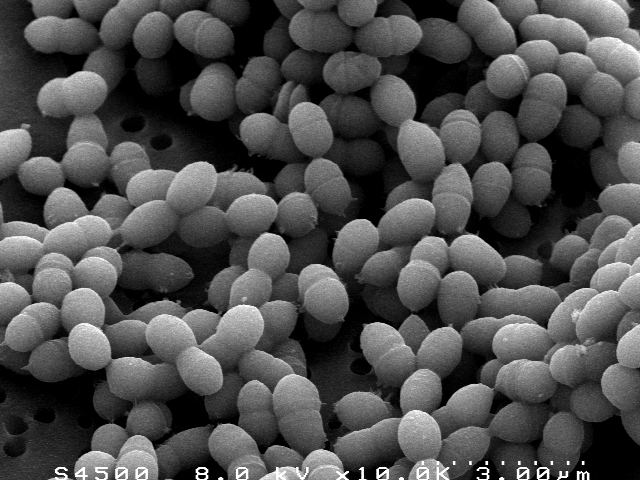
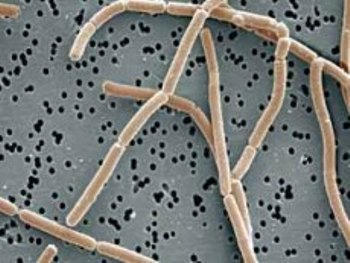

left to right
> streptococcus thermophilus
> lactobacillus delbrueckii subsp. bulgaricus
> Milk pasteurising equipment in 1953, for ensuring no other bacteria will be enrolled during the production of milk products

The home-used bacteria-pulver available in markets are mostly produced from labs, for making yoghurt consist of single species of culture
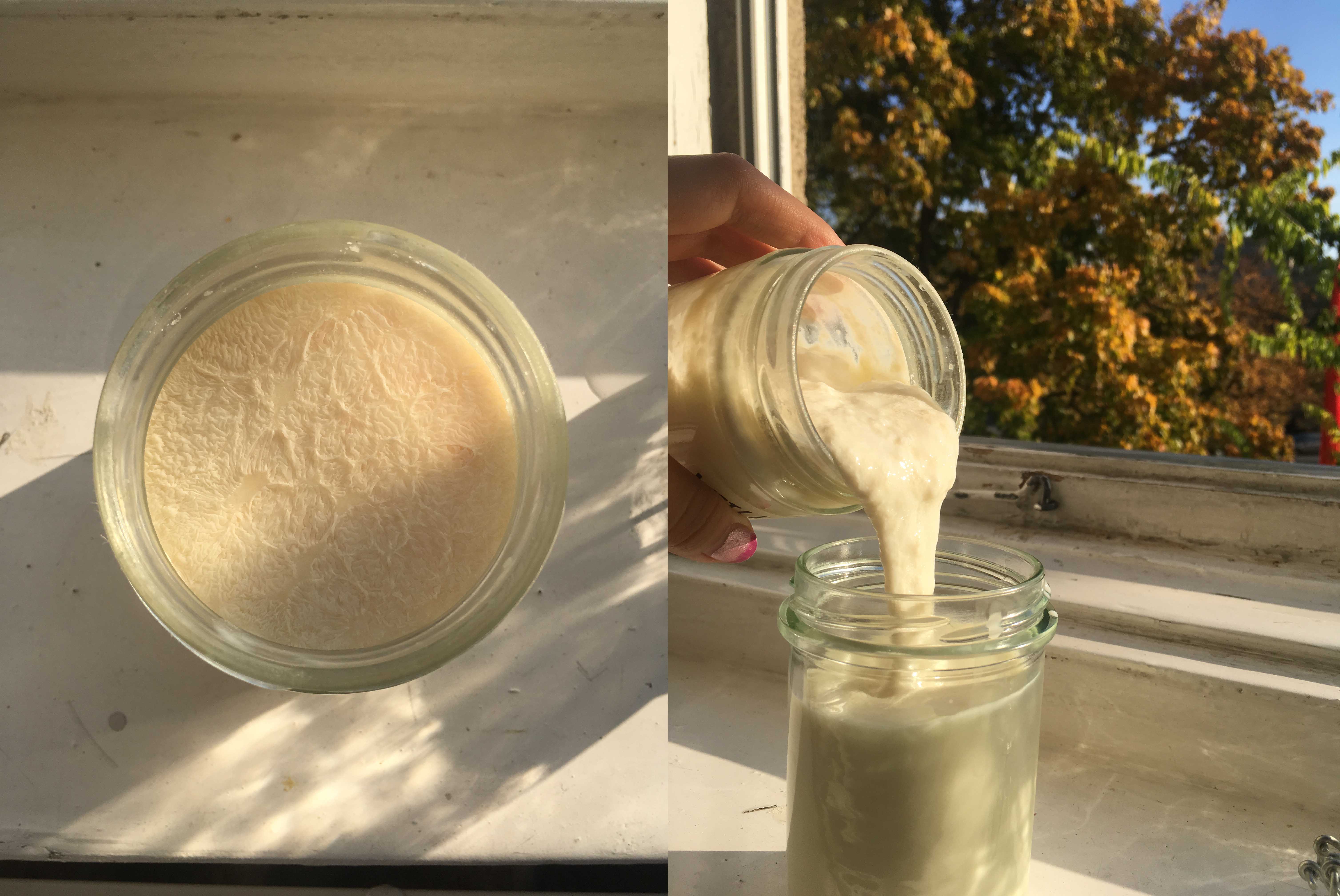
Vilii is a sort of sour milk from Finnland, which could be easily identified by their viscous and extensile appearance

Step by step, I also started to develop my little collection of cultures. I take care of these mini microbial „pet“ with friends in our atelier together. From this process, I gathered a strong feeling, that the happiness of enjoying fermented food doesn’t only come from the taste itself, but more from the interaction and communication with ferment-lovers
In comparison, the exchanging and delivering of starter on a small scale is still imaginable, a long-term and transregional preservation seems relatively tricky. In fact, considering the fermenting process of sour milk is actually the growing and activating process of lactobacillus (mesophilic or thermophilic bacteria), which means, the starter could be inactivated while changing the factor of either temperature or humidity. A good example would be, putting yoghurt into a refrigerator is for lowering down the heat to reduce the activity of yoghurt , therefore, to keep it alive for longer period. Nevertheless, for expanding the „network“ of culture exchanging, ferment-lovers need to take one more step to change another factor: dehydrating the sour milk, on purpose to allow the sour milk became more suitable for delivering.
During my search for different types of sour milk, I was fascinated by the derived forms of „storage“ and „container“ for them: Some people put cottons into sour milk and dehydrate them, someone sent me crumbs of dried sour milk, one of my friend used a tissue as media and „smuggled” some viili to Berlin… As if these mini creatures have found themselves peaceful corners in the gap of human industrial civilization for their own growth.. The most astonishing story is from the Finnish immigrants of last century, for bringing the starter culture of viili to the USA, they applied sour milk on a dried clean handkerchief, after making it dried, they would roll and put it into a bag, and transoceanically regenerate them.
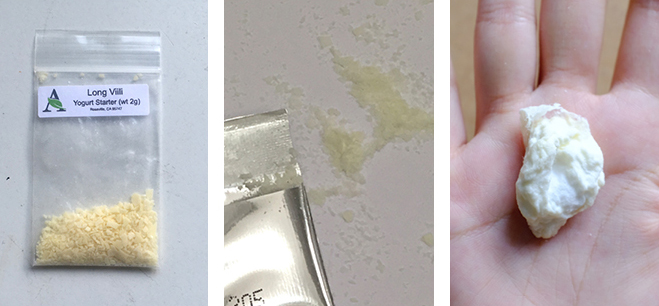
„Storage“ of starter cultures in different forms

The „activating“ process of a „storage“
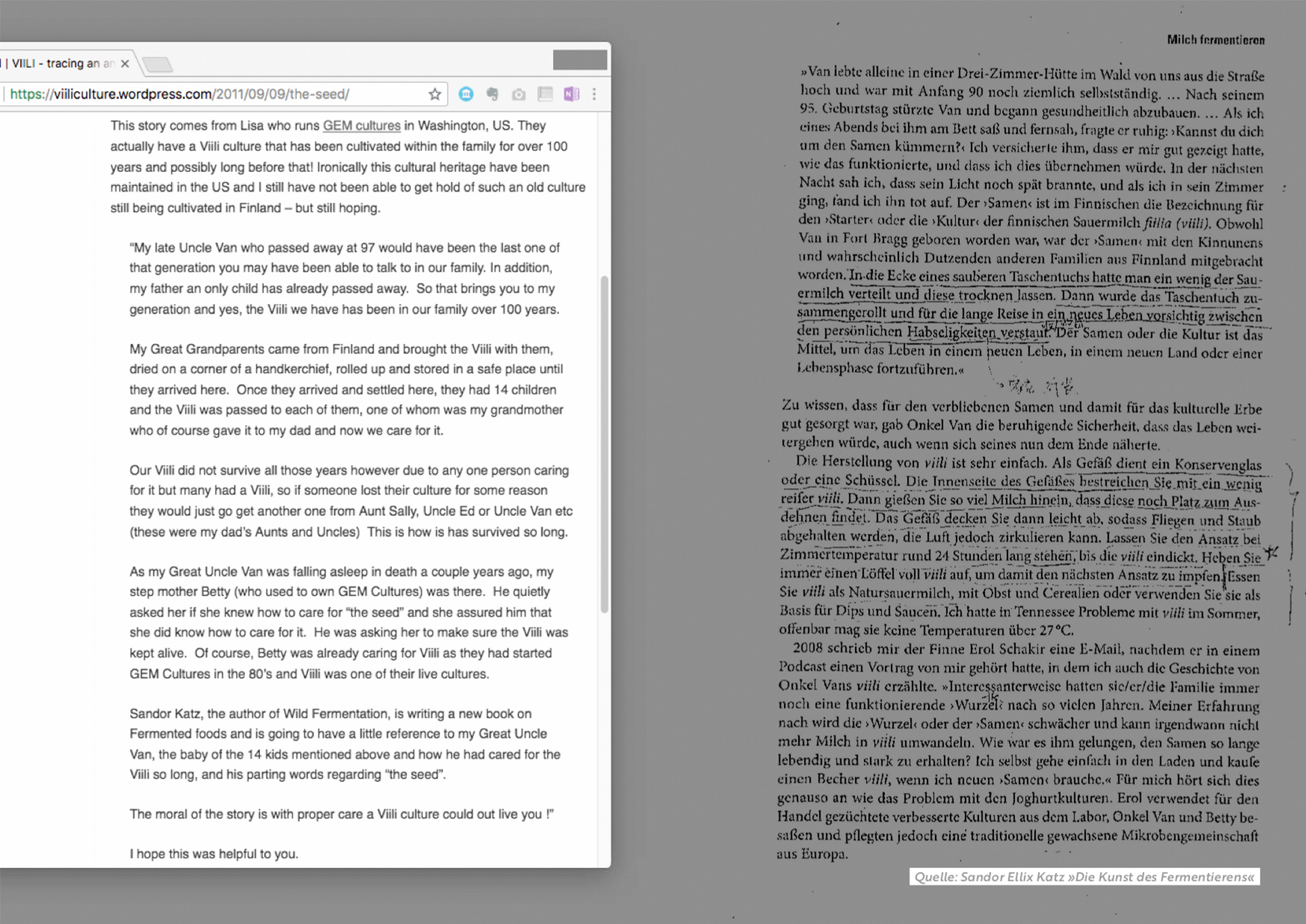
In his work The Art of Fermentation, Sandor Ellix Katz told the transportation story of viili of Finnish immigrants

After hearing the Finnish story, a friend of mine had a journey to Finland and wanted to bring me some viili, whom has been stopped in the airport because of the luggage limitation for liquid. Facing this embarrassing moment, he came up with an idea which was applying some viili onto a piece of tissue and brought the tissue back to Berlin, few days after putting the tissue in milk, the milk fermented into new viili…


Being influenced by these stories, I also tried to apply the regular yoghurt onto textile and dry them up, and used them as a starter culture
The story of Finnish immigrants led my attention towards Textile as a kind of media. Mentioning the word ‘textile’, we can always recognize the original culture of a piece of textile, by identifying their unique visual style, which results in their vernacular weaving, printing and dyeing technique. In this regard, the textile is an expression medium of a culture on a civilized level.
In Germanic languages „culture“ possesses two meanings: one is the civilized rise, one is the bacterial cultivation. In the story of Finnish immigrants, a piece of textile became a literary carrier of culture. The pun leads to a playful literary meaning. I started to think about how to use textile to convey the multi-paraphrasing of „culture“.
If I consider the process of applying sour milk on textile and dehydrating them as a transformation of textile to a „medium” or „storage“, can we beautify or regularize the presenting way of sour milk (as a content) on textile (as a container)? If the textile is a carrier for sour milk babies, are they reusable after finishing their mission? I turned my attention to the white, thick sour milk – Can this semi-liquid substance also be used as a pigment for drawing a portrait of the microorganisms in sour milk?
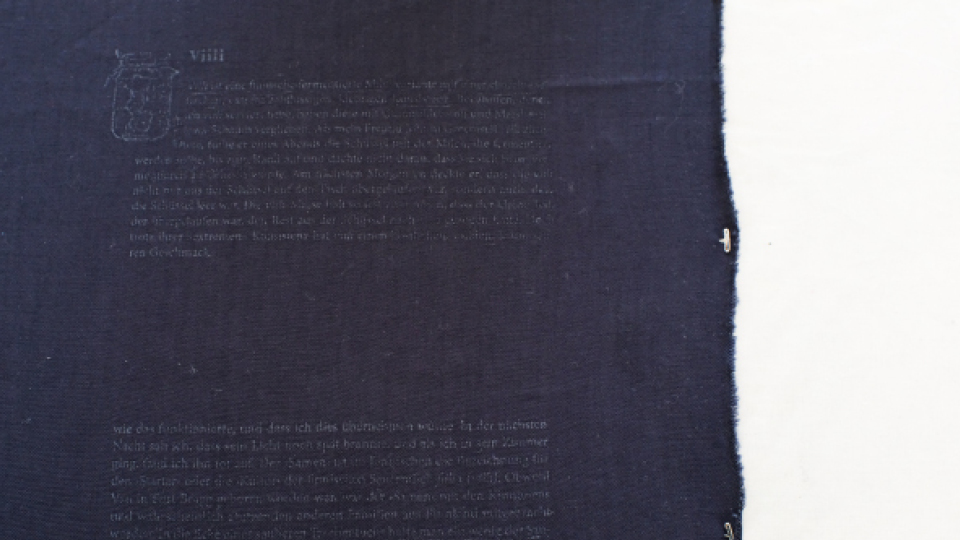
I tried to print some texts on the textile through screen printing

The patterns were inspired by the form of lactobacillus

Before and after drying
I chose three kinds of sour milk from different cultures: matsoni from Georgia, viili from Finland, filmjölk from Sweden. The fabric/pattern from each culture has its own striking personality: Geometric pattern of Georgian carpet, Finnish lattice fabric, Swedish Kubrits pattern…I extracted the most representative visual elements in each culture and designed three different flat patterns for each sour milk. The textile as a container has been divided into equal parts with the unit of 10cm *10cm. The negative patterns and the name of related sour milk were screen printed on textile with food colouring, and then the corresponding sour milk was applied on each square to cover the positive pattern. After drying, every little unit square can be cut off and used for fermenting a small bottle of sour milk starter.


The evolution of patterns design for sour milk from three cultures
︎
MAKING PROCESS
I – Screen Printing

The negative patterns of sour milk were screen printed on textile

II – Sewing

Overlocking the edges of little squares, and pulling out the lines in between
III – Applying the sour milk on fabric
 The processing method of my fabric allows people to cut them off as small squares easily, The lightness of material allows it to be inserted into any corner around. In this sense, the culture not only has the possibility of infinite extension along the longitudinal axis of time but also gets to wander around in different spatial extents whenever people walks by. I cut down pieces of my culture and shared with friends via post or visiting. Thus the micro bacteria rely on a light cloth completed their journey as a wanderer. As the natural fermentation is still full of uncertainties, from the feedbacks of friends,I learned that not every container gets a perfect result. But as a friend said: „it was fun“, I think the „ fun“ is the most substantial reason and most joyful thing, to cultivate and exchange culture, to enjoy fermented food in our daily life.
The processing method of my fabric allows people to cut them off as small squares easily, The lightness of material allows it to be inserted into any corner around. In this sense, the culture not only has the possibility of infinite extension along the longitudinal axis of time but also gets to wander around in different spatial extents whenever people walks by. I cut down pieces of my culture and shared with friends via post or visiting. Thus the micro bacteria rely on a light cloth completed their journey as a wanderer. As the natural fermentation is still full of uncertainties, from the feedbacks of friends,I learned that not every container gets a perfect result. But as a friend said: „it was fun“, I think the „ fun“ is the most substantial reason and most joyful thing, to cultivate and exchange culture, to enjoy fermented food in our daily life.🔍 Have a Look on the project

Wanderer | Masterarbeit 2018
Betreuer/in:
Axel Kufus
Johanna Schmeer
Special Thanks to
Edible Alchemy
Julia Kunz
Sandor Ellix Katz
Zining LIU
Fang HU
Dong LIU
Kailin LU
Videos feedback provided by
Filippo Maria MIRASOLE
Samuel VON DÜFFEL
Adrian BACHMANN
Yue LIU
Esmée WILLEMSEN
Juan GAEZE